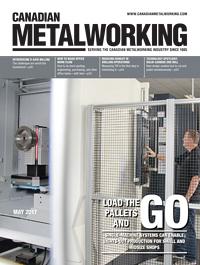Editor
- FMA
- The Fabricator
- FABTECH
- Canadian Metalworking
Technology Spotlight: Solid-carbide End Mill
New design enables tool to cut and polish simultaneously
- By Joe Thompson
- May 23, 2017
- Article
- Cutting Tools
Machine shops have many options when searching for a solid-carbide end mill. The type of end mill, geometry, and coatings all are selected based on the operation and the material being cut. Then it’s time to rough, and then finish the cut.
Typically, finishing operations, depending on the required finish, take the most time to complete. However, a new product may help reduce some of the fine-finishing time required to achieve a polished surface after cutting.
Emuge Corp., West Boylston, Mass., has introduced the Cut & Form solid-carbide finishing end mill, which features a patented tool geometry that performs two functions -- cutting and polishing -- in one operation.
According to the manufacturer, this dual functionality reduces both manufacturing time and costs.
“Cut & Form end mills are another example of innovative technology at work [that has been] designed to dramatically speed machining throughput, eliminating time, secondary operations, and cost,” said Bob Hellinger, president of Emuge Corp.
The tool’s dual functionality comes from its design, which incorporates three cutting edges to remove material and three burnishing edges to compact the material. This produces polished mirror surfaces as fine as 0.08-μm Ra.
With the “cutting” edge, the tool creates a machining process that uses very small stock material (0.004 to 0.008 in.) for the pressure ridges to produce a polished surface.
The geometry of the tool (see Figure 1) has cutting edges that remove material [shown in red] and pressure ridges that compact and smooth the material to produce polished surfaces [shown in green].
“The unique design of the solid-carbide end mills is not only the polished surface quality, but also the surface quality of the pressure ridges. These pressure ridges are designed to compact and smooth the material,” explained Dan Doiron, Emuge milling products manager.
The surface quality is also dependent on the coolant, said Doiron, with optimal results produced using minimum quantity lubricant (MQL) oil.
“This medium is 100 per cent free from other microparticles in comparison to standard emulsion coolant. However, coolant can also be used with success if oil application is not desired,” said Doiron.
The tool is suitable for trimming 2-D contours in nonferrous materials, such as aluminum and copper.
“The development stemmed in part from a customer in the communications industry who was looking to finish the exterior of an aluminum housing and wanted a polished surface that did not require any additional polishing after the milling process,” said Doiron.
Its use on nonferrous materials is based on the tensile strengths of those materials.
“The higher the tensile strength, the more critical it is in the compaction of the material,” said Doiron. “Nonferrous materials have a lower tensile strength that requires less cutting force than that of steel or hardened materials.”
The other important item to note is the substrate of the tool. It is made from solid carbide, which is very hard, and too much force on the tool can prevent the optimal surface finish from being attained in harder materials.
The end mill is available in two types, stub length and standard length, with cutting diameters of 6, 8, 10, and 12 mm.
Emuge Corp., 800-323-3013, www.emuge.com
Editor Joe Thompson can be reached at jthompson@canadianmetalworking.com.
About the Author

Joe Thompson
416-1154 Warden Avenue
Toronto, M1R 0A1 Canada
905-315-8226
Joe Thompson has been covering the Canadian manufacturing sector for more than two decades. He is responsible for the day-to-day editorial direction of the magazine, providing a uniquely Canadian look at the world of metal manufacturing.
An award-winning writer and graduate of the Sheridan College journalism program, he has published articles worldwide in a variety of industries, including manufacturing, pharmaceutical, medical, infrastructure, and entertainment.
Related Companies
subscribe now


Keep up to date with the latest news, events, and technology for all things metal from our pair of monthly magazines written specifically for Canadian manufacturers!
Start Your Free Subscription- Industry Events
MME Winnipeg
- April 30, 2024
- Winnipeg, ON Canada
CTMA Economic Uncertainty: Helping You Navigate Windsor Seminar
- April 30, 2024
- Windsor, ON Canada
CTMA Economic Uncertainty: Helping You Navigate Kitchener Seminar
- May 2, 2024
- Kitchener, ON Canada
Automate 2024
- May 6 - 9, 2024
- Chicago, IL
ANCA Open House
- May 7 - 8, 2024
- Wixom, MI






















